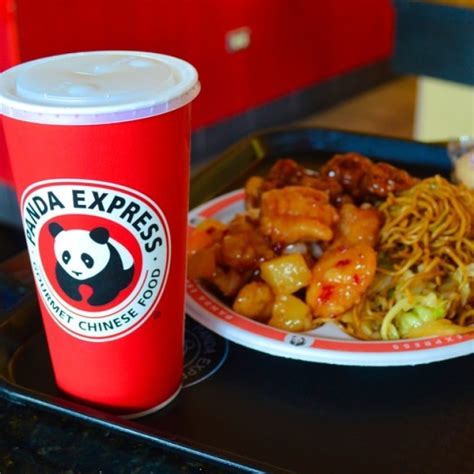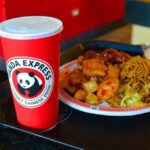
Panda Express, a ubiquitous symbol of American Chinese cuisine, faces evolving consumer tastes and increased competition, prompting questions about its future relevance and ability to maintain its dominance in the fast-casual dining sector. With a menu largely unchanged since its inception and a growing demand for more authentic and diverse Asian flavors, the chain is under pressure to adapt or risk losing its appeal.
Founded in 1983 by Andrew and Peggy Cherng, Panda Express rose from humble beginnings in a Glendale, California, mall to become the largest Asian segment chain in the United States, boasting over 2,400 locations and generating billions in annual revenue. Its signature dish, Orange Chicken, has become a cultural phenomenon, synonymous with American Chinese food. However, this very success and widespread familiarity may now be contributing to the challenges it faces.
The core issue lies in the changing perception of Chinese food in America. For decades, Panda Express defined the category for many, offering a standardized, accessible, and affordable version of Chinese-inspired dishes. However, as American palates have become more sophisticated and exposed to a wider array of global cuisines, including regional Chinese specialties, the chain’s simplified and often sweet offerings are viewed by some as inauthentic and lacking in culinary depth.
“The landscape of Chinese food in America has changed dramatically,” explains Jennifer 8. Lee, a journalist and author who has written extensively about Chinese cuisine in the U.S. “What was once innovative and exciting is now seen by some as a caricature of Chinese food.”
This shift in perception is exacerbated by the rise of independent restaurants and smaller chains that offer more authentic and diverse Chinese and Asian dishes. These establishments often cater to specific regional cuisines, such as Sichuan, Cantonese, or Taiwanese, providing a level of culinary experience that Panda Express struggles to match.
Moreover, the increasing popularity of other Asian cuisines, such as Korean, Vietnamese, and Thai, has further diversified the dining landscape, drawing customers away from traditional American Chinese fare. The availability of these options, often perceived as healthier and more flavorful, presents a significant challenge to Panda Express’s market share.
The company acknowledges the need to adapt and has been experimenting with new menu items and store formats. In recent years, Panda Express has introduced dishes like Beyond Orange Chicken, a plant-based alternative, and explored healthier options with its Wok Smart menu. It has also tested new restaurant designs and digital ordering platforms to enhance the customer experience.
“We are constantly listening to our guests and evolving our menu to meet their changing tastes and preferences,” says Andrea Cherng, Chief Brand Officer of Panda Restaurant Group. “Innovation is a key part of our DNA, and we are committed to providing our guests with delicious and satisfying experiences.”
However, these efforts may not be enough to overcome the fundamental perception problem. Critics argue that Panda Express’s core menu remains largely unchanged and that its attempts at innovation are often superficial and fail to address the underlying desire for more authentic and diverse flavors.
The challenge for Panda Express is to balance its commitment to its established brand identity and loyal customer base with the need to evolve and appeal to a new generation of diners. This requires a delicate balancing act: preserving the familiar flavors that have made it successful while introducing new dishes and culinary concepts that reflect the evolving tastes of American consumers.
One potential strategy is to embrace regional Chinese cuisines and offer a more diverse menu that showcases the breadth and depth of Chinese culinary traditions. This could involve partnering with chefs and culinary experts to develop authentic recipes and training programs for its staff.
Another approach is to focus on improving the quality of its ingredients and cooking techniques. By using fresh, locally sourced ingredients and employing more skilled chefs, Panda Express could elevate the culinary experience and address criticisms about the chain’s perceived lack of authenticity.
Ultimately, the success of Panda Express will depend on its ability to adapt to the changing landscape of American Chinese food and to convince consumers that it is more than just a purveyor of standardized, mass-produced dishes. The chain must demonstrate a genuine commitment to culinary excellence and a willingness to embrace the diversity and richness of Chinese cuisine.
Detailed Analysis:
Panda Express’s dominance in the American Chinese fast-casual market is facing unprecedented scrutiny and challenges, stemming from a confluence of factors that highlight the evolving dynamics of the food industry and consumer preferences. The chain, renowned for its widespread accessibility and signature dishes like Orange Chicken, finds itself at a crossroads, needing to innovate and adapt to maintain its relevance in an increasingly competitive and sophisticated culinary landscape.
The Rise and Reign of Panda Express:
Founded in 1983 by Andrew and Peggy Cherng, Panda Express capitalized on a growing demand for convenient and affordable Chinese-inspired food in the United States. Its success was built on a foundation of standardization, consistency, and a menu tailored to American palates. The Orange Chicken, a sweet and tangy fried chicken dish, became a cultural phenomenon, establishing Panda Express as a household name and a symbol of American Chinese cuisine.
The chain’s rapid expansion and franchising model allowed it to establish a vast network of locations, making it accessible to a wide range of consumers across the country. Its appeal lay in its ability to deliver a consistent and predictable dining experience, catering to those seeking a quick and familiar meal.
The Evolving Culinary Landscape:
However, the very factors that contributed to Panda Express’s success are now posing significant challenges. As American palates have become more sophisticated and exposed to a wider range of culinary influences, the chain’s simplified and standardized menu is increasingly viewed as inauthentic and lacking in culinary depth.
The rise of independent restaurants and smaller chains offering more authentic and diverse Chinese and Asian dishes has further intensified the competition. These establishments often specialize in specific regional cuisines, such as Sichuan, Cantonese, or Taiwanese, providing a level of culinary experience that Panda Express struggles to match.
Furthermore, the increasing popularity of other Asian cuisines, such as Korean, Vietnamese, and Thai, has diversified the dining landscape, drawing customers away from traditional American Chinese fare. These cuisines are often perceived as healthier, more flavorful, and more authentic, presenting a significant challenge to Panda Express’s market share.
The Authenticity Debate:
The debate surrounding the authenticity of Panda Express’s food is a central issue in the discussion about its future. Critics argue that the chain’s menu is a far cry from traditional Chinese cuisine and that its dishes are often overly sweet and lacking in the complex flavors and techniques that characterize authentic Chinese cooking.
“People are starting to realize that what they thought was Chinese food is not actually Chinese food,” says Fuchsia Dunlop, a food writer and expert on Chinese cuisine. “There’s a growing awareness of the richness and diversity of Chinese regional cuisines, and people are looking for more authentic experiences.”
This perception problem is exacerbated by the fact that many Americans’ first exposure to Chinese food is through chains like Panda Express. As a result, the chain’s offerings often become the benchmark against which other Chinese restaurants are judged, perpetuating a cycle of misrepresentation and limiting consumers’ understanding of the true breadth and depth of Chinese culinary traditions.
Panda Express’s Response:
Panda Express recognizes the need to adapt to the changing culinary landscape and has been experimenting with new menu items and store formats. In recent years, the chain has introduced dishes like Beyond Orange Chicken, a plant-based alternative, and explored healthier options with its Wok Smart menu. It has also tested new restaurant designs and digital ordering platforms to enhance the customer experience.
The introduction of Beyond Orange Chicken, in particular, reflects the chain’s attempt to cater to the growing demand for plant-based options and to appeal to a younger generation of diners who are more conscious about their dietary choices. The Wok Smart menu, which features dishes with lower calorie counts and healthier ingredients, is another example of Panda Express’s efforts to address changing consumer preferences.
However, these efforts have been met with mixed reactions. Some critics argue that the chain’s attempts at innovation are often superficial and fail to address the underlying desire for more authentic and diverse flavors. They contend that the core menu remains largely unchanged and that the new offerings are simply variations on existing themes.
The Path Forward:
The challenge for Panda Express is to balance its commitment to its established brand identity and loyal customer base with the need to evolve and appeal to a new generation of diners. This requires a delicate balancing act: preserving the familiar flavors that have made it successful while introducing new dishes and culinary concepts that reflect the evolving tastes of American consumers.
One potential strategy is to embrace regional Chinese cuisines and offer a more diverse menu that showcases the breadth and depth of Chinese culinary traditions. This could involve partnering with chefs and culinary experts to develop authentic recipes and training programs for its staff.
By featuring dishes from different regions of China, such as Sichuan, Cantonese, or Hunan, Panda Express could offer a more nuanced and authentic culinary experience that appeals to more adventurous diners. This would also help to dispel the misconception that Chinese food is a monolithic entity and to showcase the rich diversity of Chinese culinary traditions.
Another approach is to focus on improving the quality of its ingredients and cooking techniques. By using fresh, locally sourced ingredients and employing more skilled chefs, Panda Express could elevate the culinary experience and address criticisms about the chain’s perceived lack of authenticity.
Investing in better ingredients and training could also help to improve the overall flavor and presentation of its dishes, making them more appealing to discerning diners. This would require a significant investment in resources and infrastructure, but it could ultimately be a worthwhile investment in the long-term viability of the chain.
Furthermore, Panda Express could explore the possibility of partnering with independent Chinese restaurants or chefs to create limited-time menu items or collaborative dining experiences. This would allow the chain to tap into the expertise of culinary professionals who are deeply rooted in Chinese culinary traditions and to offer its customers a taste of something truly authentic.
The Competitive Landscape:
Panda Express faces competition from a variety of sources, including independent Chinese restaurants, smaller regional chains, and other Asian-inspired fast-casual concepts. These competitors often offer more authentic and diverse menus, as well as a more personalized and intimate dining experience.
Independent Chinese restaurants, in particular, pose a significant challenge to Panda Express’s dominance. These establishments are often family-owned and operated and offer a wide range of regional specialties that are not typically found on the menus of large chains. They also tend to use fresher ingredients and more traditional cooking techniques, resulting in a more authentic and flavorful culinary experience.
Smaller regional chains, such as Din Tai Fung and HaiDiLao Hot Pot, have also gained popularity in recent years, offering a more upscale and specialized dining experience. These chains often focus on specific regional cuisines or culinary concepts and cater to a more discerning clientele.
Other Asian-inspired fast-casual concepts, such as Chipotle and Sweetgreen, also compete with Panda Express for market share. These chains offer a wider range of cuisines and menu options, as well as a more customizable and health-conscious dining experience.
The Future of Panda Express:
The future of Panda Express depends on its ability to adapt to the changing culinary landscape and to convince consumers that it is more than just a purveyor of standardized, mass-produced dishes. The chain must demonstrate a genuine commitment to culinary excellence and a willingness to embrace the diversity and richness of Chinese cuisine.
This will require a significant investment in resources and infrastructure, as well as a willingness to take risks and experiment with new concepts. However, if Panda Express can successfully navigate these challenges, it has the potential to remain a dominant force in the American Chinese food market for years to come.
The chain’s established brand recognition, vast network of locations, and loyal customer base provide a solid foundation for future growth and innovation. By embracing authenticity, improving quality, and diversifying its menu, Panda Express can reposition itself as a leader in the evolving world of American Chinese cuisine.
Ultimately, the success of Panda Express will depend on its ability to listen to its customers, adapt to changing tastes, and stay true to its commitment to providing delicious and satisfying experiences. The chain must evolve from a purveyor of standardized dishes to a champion of Chinese culinary diversity and excellence.
FAQ:
1. What are the main challenges Panda Express faces today?
Panda Express is facing challenges due to evolving consumer tastes, increased competition from restaurants offering more authentic and diverse Asian cuisines, and a perception that its menu is standardized and lacks culinary depth. The rise of smaller chains and independent restaurants specializing in regional Chinese dishes also contributes to the competitive pressure.
2. How is Panda Express attempting to address these challenges?
Panda Express is experimenting with new menu items like Beyond Orange Chicken (a plant-based option) and healthier choices under its “Wok Smart” menu. They are also testing new restaurant designs and digital ordering platforms to improve customer experience and appeal to changing consumer preferences.
3. What is the “authenticity debate” surrounding Panda Express?
The debate centers on the perception that Panda Express’s offerings are a simplified and Americanized version of Chinese cuisine, lacking the complexity and depth of traditional dishes. Critics argue that it doesn’t accurately represent the breadth and diversity of Chinese culinary traditions.
4. What strategies could Panda Express employ to improve its image and competitiveness?
Panda Express could embrace regional Chinese cuisines by diversifying its menu and partnering with chefs specializing in authentic recipes. Improving the quality of ingredients, using fresher produce, and investing in skilled chefs could also elevate the culinary experience and address concerns about authenticity.
5. How significant is the competition from other Asian cuisines like Korean, Vietnamese, and Thai?
The increasing popularity of these cuisines poses a significant challenge as they are often perceived as healthier, more flavorful, and more authentic alternatives to American Chinese food, drawing customers away from Panda Express and impacting its market share.
6. How does the Panda Express model impact the authenticity of its food?
The chain’s franchising model and focus on standardization, while contributing to its widespread accessibility, often lead to compromises in ingredient quality and cooking techniques to ensure consistency across locations. This standardization can detract from the authentic flavors and nuances of regional Chinese cuisine.
7. What role does innovation play in the future of Panda Express?
Innovation is crucial for Panda Express to stay relevant. However, it must go beyond superficial changes. It requires incorporating authentic recipes, better ingredients, and adapting to dietary trends while preserving the core flavors that have made the brand successful.
8. How has American perception of Chinese food changed over time?
Initially, American Chinese food was considered exotic and innovative. However, as exposure to diverse cuisines grew, consumers became more discerning, seeking more authentic regional dishes and complex flavors. Panda Express, once a pioneer, is now sometimes viewed as a caricature of Chinese food by some.
9. What is the impact of online food delivery services on Panda Express’s market share?
Online food delivery services have intensified competition, allowing customers to easily access a wider range of dining options, including smaller, independent restaurants specializing in diverse Asian cuisines. Panda Express must enhance its online presence and delivery options to remain competitive.
10. How can Panda Express leverage its brand recognition to attract new customers?
Panda Express can leverage its brand recognition by introducing higher-quality ingredients, authentic recipes, and collaborations with acclaimed chefs. It could highlight its history and commitment to quality, emphasizing the evolution of its menu and its dedication to culinary excellence.
11. Is Panda Express making an effort to focus on the nutritional value of its dishes?
Yes, Panda Express has introduced its “Wok Smart” menu, which features dishes with lower calorie counts and healthier ingredients, indicating an effort to cater to health-conscious consumers.
12. What are some examples of partnerships or collaborations that Panda Express could pursue?
Panda Express could partner with renowned Chinese chefs to develop authentic regional dishes, collaborate with food bloggers and influencers to promote its updated menu, and team up with local farmers to source fresh ingredients.
13. How important is customer feedback in the adaptation process for Panda Express?
Customer feedback is critical. Panda Express needs to actively listen to customer preferences, reviews, and suggestions to refine its menu and improve its overall dining experience, ensuring it aligns with evolving consumer tastes.
14. What is the future of Orange Chicken in the context of changing culinary preferences?
While Orange Chicken remains a popular signature dish, Panda Express may need to offer variations with different spice levels, sauces, or preparation methods to appeal to a wider range of tastes. Maintaining its appeal while introducing more sophisticated options is essential.
15. What is the significance of Beyond Orange Chicken in Panda Express’s strategy?
Beyond Orange Chicken represents Panda Express’s attempt to cater to the growing demand for plant-based options and to appeal to younger, more environmentally conscious consumers. It allows the chain to expand its customer base and stay relevant in a changing market.
16. Does Panda Express focus on community engagement or local sourcing?
While not heavily emphasized in the source material, increasing focus on local sourcing and community engagement could enhance Panda Express’s image and appeal. Partnering with local farms and participating in community events can foster goodwill and promote its commitment to quality.
17. What role do cultural sensitivity and representation play in the debate surrounding Panda Express?
Cultural sensitivity is essential. Panda Express must be mindful of the cultural origins of its dishes and avoid perpetuating stereotypes. Accurate representation of Chinese culinary traditions can help build trust and credibility with consumers.
18. How can Panda Express effectively communicate its efforts to improve authenticity and quality?
Panda Express should transparently communicate its efforts through marketing campaigns, social media, and in-store materials. Highlighting partnerships with chefs, sourcing practices, and the evolution of its menu can help consumers understand and appreciate the changes.
19. What are the potential long-term consequences if Panda Express fails to adapt to changing tastes?
If Panda Express fails to adapt, it risks losing market share to competitors offering more authentic and diverse options. Its brand image could suffer, leading to decreased customer loyalty and ultimately, a decline in revenue and relevance.
20. How does Panda Express handle criticisms regarding its food quality and taste?
The source does not explicitly detail Panda Express’s specific response mechanisms to criticisms. However, proactive engagement with customer reviews, feedback surveys, and social media monitoring is essential. Addressing concerns transparently and implementing changes based on feedback can help improve its reputation and retain customers.


![Oreo’s [Flavor Name] So Good, Petition to Make It Permanent!](https://duniateknoku.com/wp-content/uploads/2025/06/unnamed-file-876-150x150.jpg)


![Oreo’s [Flavor] So Good, Fans May Demand Permanent Status!](https://duniateknoku.com/wp-content/uploads/2025/06/unnamed-file-873-150x150.jpg)



